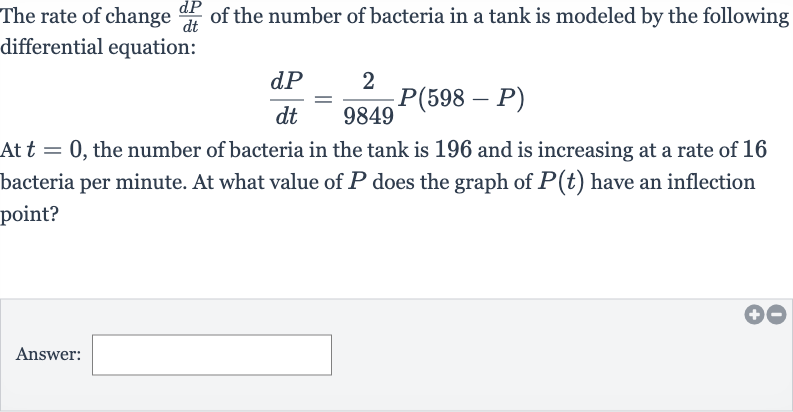AI tutor
Welcome to Bytelearn!
Let’s check out your problem:

The rate of change of the number of bacteria in a tank is modeled by the following differential equation:At , the number of bacteria in the tank is and is increasing at a rate of bacteria per minute. At what value of does the graph of have an inflection point?Answer:
Full solution
Q. The rate of change of the number of bacteria in a tank is modeled by the following differential equation:At , the number of bacteria in the tank is and is increasing at a rate of bacteria per minute. At what value of does the graph of have an inflection point?Answer:
- Find First Derivative: To find the inflection point, we need to find the second derivative of with respect to and set it equal to zero. The second derivative will tell us where the concavity of the graph changes, which is the inflection point.First, let's find the first derivative, which is given by the differential equation:
- Find Second Derivative: Now, we need to find the second derivative . To do this, we will differentiate with respect to and then multiply by again due to the chain rule.
- Differentiate First Derivative: Differentiating with respect to gives us:
- Multiply Derivatives: Now, we multiply this derivative by to get the second derivative with respect to time:
- Set Second Derivative Equal to Zero: To find the inflection point, we set the second derivative equal to zero and solve for :
- Simplify Equation: We can simplify the equation by setting the factors equal to zero: or
- Solve for P: Solving the first equation for P gives us:
- Disregard Endpoints: Solving the second equation for gives us two solutions: or or
- Identify Inflection Point: However, since we are looking for the inflection point where is changing, we disregard the solutions and because they represent the endpoints of the interval where the population exists. The inflection point occurs at .
More problems from Find instantaneous rates of change
QuestionGet tutor help
QuestionGet tutor help
QuestionGet tutor help
QuestionGet tutor help
QuestionGet tutor help
QuestionGet tutor help
QuestionGet tutor help
QuestionGet tutor help
